
|
Features
|
|
|
|
Books
|
|
|
|
Fun & Games
|
|
|
|
Contact Us
|
|
|
John's Journal... Entry 236, Day 3
THE TURKEY HATCH FOR 2004
More States' Spring Forecast for Turkey Hunting
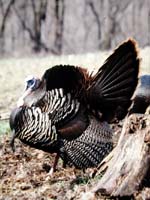 Editor's
Note: Long rainy periods impacted the turkey hatch in various parts of
the country last year. However, most sections of the Midwest experienced
a positive turkey hatch. Several western states, including Arizona, California
and New Mexico reported good turkey hatches. But if you want to know what
you can expect this year when you go into the woods to hunt spring turkeys,
check out each state's predictions in the Hatch Report this week.
Editor's
Note: Long rainy periods impacted the turkey hatch in various parts of
the country last year. However, most sections of the Midwest experienced
a positive turkey hatch. Several western states, including Arizona, California
and New Mexico reported good turkey hatches. But if you want to know what
you can expect this year when you go into the woods to hunt spring turkeys,
check out each state's predictions in the Hatch Report this week.
Maryland:
Wild Turkey and Upland Game Project Manager Bob Long explained that Maryland
had a poor 2003 hatch, significantly lower than the good hatch in 2002.
The poor reproduction probably resulted from poor first nestings and poor
poult survival, although late nestings appeared to fare better than the
earlier nesting attempts. According to Long, Allegany and Washington Counties,
in the western portion of the state, had the highest harvest with 3.1
poults per hen, but still below the state's long-term average of 4 poults
per hen. "The worst areas for the spring turkey harvest included the remainder
of the state, with between 1- and 1.5-poults per hen spotted in the central,
southern and eastern regions of Maryland. Maryland should have a moderate
amount of 2-year-old birds available in 2004. Approximately half of the
state experienced an average reproduction in 2002, and gobblers should
be abundant in those places. But poor production in 2002 will likely limit
the amount of gobblers on the eastern shore for 2004."
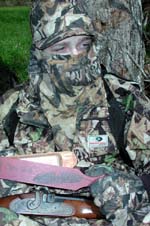 Massachusetts:
Massachusetts:
Massachusetts did not have all of the brood-survey reports available at
the time of this writing on the quality of the 2003 hatch to compare it
to the 2002 hatch. Initial reports suggested that many hens nested late
or re-nested. According to Jim Cardoza, the first nesting often rated
poor, due to rainy weather. Re-nesting appeared reasonably good, but later
than the 2002 hatch. Massachusetts did not make regional distinctions
since the state pooled the hatch data for the entire state and did not
make predictions for the number of harvestable gobblers for the 2004 spring.
Michigan:
"This year, Michigan experienced a good turkey hatch," says Al Stewart,
a wildlife biologist and upland game bird specialist. The hatch in 2003
appeared similar to the 2002 hatch, but the cold, rainy weather did affect
the hatch's quality. Stewart stated that the southern part of peninsula
had the best 2003 hatch, while the northern part of the peninsula had
a poorer hatch. He predicted the state would have a good harvest for the
2004 season.
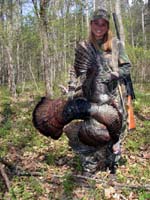 Minnesota:
Minnesota:
Minnesota had a record-breaking 2003 hatch with a reported 7,650 wild
turkeys harvested compared to the 2002 hatch numbers of 6,516 gobblers
harvested. "Overall it was another excellent year," Gary Nelson, supervisor
of the Department of Natural Resources' wild turkey trapping program.
Mild weather, additional permits and expanding turkey range continued
to provide hunters with good opportunities to harvest spring turkeys.
Some of this year's hunting success can be attributed to Minnesota chapters
of the National Wild Turkey Federation and revenues generated from the
sale of turkey stamps. Money raised from these sources went to habitat
restoration and continuing research on the state's wild turkey population."
The best harvest came from Houston County in the southeastern region of
the state. Although the state had no official numbers for the region with
the worst harvest, hunter success by permit area listed Kandiyohi and
Meeker counties in the central portion of Minnesota as the locations with
the poorest hatch. Minnesota had no predictions for the 2004 turkey hatch
at the time of this writing.
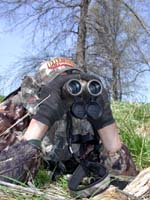 Mississippi:
Mississippi:
According to Ron Seiss, wild-turkey program coordinator for Mississippi,
the state had a fair hatch in 2003, falling slightly from 2002, the second
consecutive year that hatch numbers had fallen. Above-average rainfall
during the spring and the summer impacted the turkey hatch for the majority
of the state. Mississippi didn't have the brood survey completed yet,
so Seiss explained that he had no way of identifying the best and the
worst areas for the hatch. Seiss predicted that hunters would have their
picks of 35,000 harvestable 2-year-old birds during the 2004 season.
Missouri:
Missouri's spring turkey harvest reached an all-time high in 2003 with
hunters harvesting 58,421 gobblers. Turkey populations remained in good
shape throughout the state. Hunters during the 2003 spring season encountered
a slightly below-average number of jakes, and, the state's turkey reproduction
also ranked below average. Regionally, the turkey harvest included 8,034
taken in the northeast region, 8,063 in the northwest, 7,973 in the central,
6,731 in the southwest, 8,013 in the Ozark region, 5,369 in the southeast,
3,955 in the St. Louis urban region and 6,623 in the Kansas City metropolitan
region. Wildlife biologist Jeff Beringer says, "Missouri's turkey reproduction
also was below average in 2001. This information could mean that hunters
may face a tougher challenge in 2004. Like any wild species, turkeys have
good years and bad years. Even though reproduction has been off a little
the last two years, it still is well within the variation that's expected
from year to year. However, we may have fewer 2-year-old gobblers for
the next couple of years."
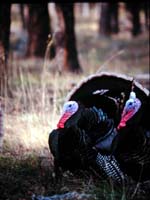 Montana:
Montana:
Although Montana doesn't collect hatch information, Jeff Herbert reports
that, "In general, nesting and brood-rearing conditions appeared to be
good for most upland birds." Herbert couldn't make a prediction for the
2004 turkey harvest.
Nebraska:
While Nebraska hadn't compiled its surveys as of this writing, Kit Hams,
a wildlife biologist, states that, "The hatch was probably excellent,
considering that Nebraska was warm and dry throughout most of the nesting
and brood-rearing periods. Although this dry weather was bad for farming,
it's generally good for bird production." Hams announced the excellence
of the 2002 hatch and an above-average 2003 hatch. Hams estimated that
the southwest area of the state probably had the best hatch, because of
its high turkey population. But he couldn't name the worst area statewide
for the 2003 hatch. "Nebraska had a record harvest in 2003 with 10,500
birds," Hams mentions. "We'll probably set a new record in 2004, since
we'll offer unlimited permits."
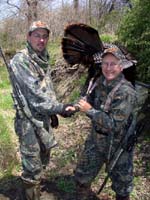 Nevada:
Nevada:
San Stiver, staff biologist, explained that Nevada didn't conduct formal
brood surveys to monitor production because of the highly-restrictive
turkey distribution and numbers. Hunting Nevada turkeys remained a novelty.
Accordingly, Nevada didn't make recommendations or predictions for the
2004 hatch.
To learn addresses and websites where you can learn more about each state's turkey hunting seasons, go to www.nighthawkpublications.com/freetips/freetips18.htm.
TOMORROW: LEARN ABOUT HOW STATES' SPRING TURKEY HUNTING WILL FARE
Check back each day this week for more about THE TURKEY HATCH FOR 2004 ...
Day 1 - The Spring Forecast
Day 2 - What to Expect This Spring for Spring
Turkey Hunting
Day 3 - More States' Spring Forecast for
Turkey Hunting
Day 4 - Learn More About How States' Spring
Turkey Hunting Will Fare
Day 5 - See Turkey Hatch Reports from Several
States